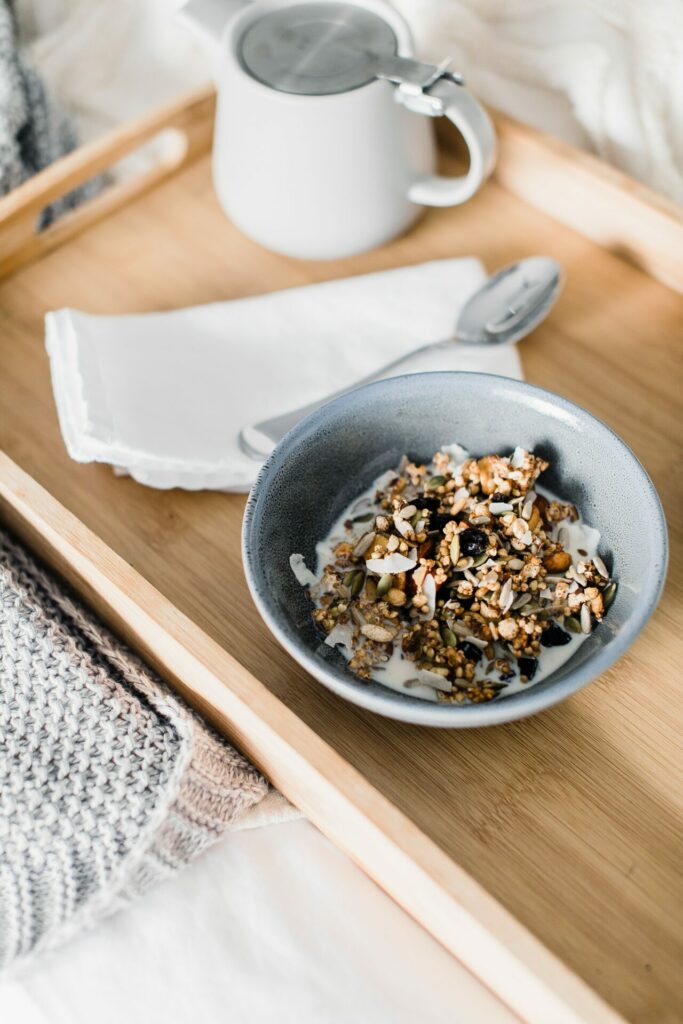Ayurveda is a five-thousand-year-old healing art of India and the sister science to yoga. Ayurveda provides a lot of insight into how your body responds to your environment at any given moment and offers tools that can support you in attaining a state of balance. In Ayurveda there are five elements: earth, water, fire, air and ether. These elements come together to form our dosha. Our dosha is our constitution and helps us to understand more about ourselves physically, intellectually, emotionally and spiritually. A combination of earth and water elements is kapha dosha. A combination of fire and water elements is pitta dosha. A combination of air and ether elements is vata dosha. Each person has a bit of each dosha in them, and the doshas come in and out of balance depending on a number of factors, including, but not limited to, the season, the food we eat, the music we listen to, the programming we watch, the company we keep, and our activity level.
After giving birth, the body experiences a vata imbalance. Vata is heightened as the postpartum mother experiences the loss of a lot of energy, blood and other fluids; empty space in the abdomen; cold; and fatigue. Therefore, it is recommended to avoid food and lifestyle choices that will further increase vata and instead turn the focus to calming or lessening vata. To calm vata, we nurture the mother’s body and mind using heavy, warm, oily, smooth, and stable qualities. These qualities will enable healing and restore balance among the doshas.
Let’s explore some Ayurvedic diet and lifestyle choices that can be helpful in restoring balance to the postpartum mother’s constitution.
Diet: Since the postpartum period is a time when vata dosha is out of balance, it is best to avoid foods that will increase vata dosha. Generally, warm or room temperature food and drink is best. Ayurveda says that eating crunchy foods will exacerbate the excess vata in a new mother’s system, which could disrupt digestion and cause airy, anxious mental states. Some specific foods and drinks that increase vata are broccoli, cauliflower, brussels sprouts, cabbage, lettuce and iced drinks (water, smoothies, etc.). Instead of the foregoing food and drink, new mothers should focus on warm teas, porridges, soups and stews. Smoothies, if at room temperature, are also acceptable as are easy to digest, high-energy foods like nuts and fruits. From an Ayurvedic perspective, drinking hot water throughout the day is also highly recommended as hot water is warming, nurturing and very soothing for the gut. In Ayurveda, it is suggested that women eat a diet of kitchari for at least 40 days postpartum. Kitchari is a lentil porridge that provides all of the nutrients, vitamins and minerals a mother needs to feel replenished after birth. Ghee (clarified butter) is also a superstar in the postpartum diet because it provides lubrication to the organs and aids in digestion. Stirring ghee into foods the mother is already eating (like, oatmeal) will make these foods easier to digest and restore the mother’s depleted state. A key principle of Ayurveda generally is to strengthen the digestive fire (Agni); this is true in the postpartum period as well.
Rest: In Ayurveda, it is said that for a mother to move around outside after birth is equivalent to leaving all of the doors and windows of her house wide open and allowing the drying, physically and mentally disturbing winds of vata to whip around and through its rooms. Thus, from an Ayurvedic perspective, the recommendation to the postpartum mother is: lie low. Let your postpartum support team take care of you and all of your traditional responsibilities. Focus on healing and bonding with your baby in the early weeks instead of getting back to “it,” whatever that might be for you.
Massage: In Ayurveda, Abhyanga is self-massage that stimulates the neuropeptides of the skin to activate production of oxytocin. Oxytocin is the love hormone responsible for many reproductive functions. It plays a role in labor and delivery, lactation, early attachment, and bonding. Oxytocin works by flooding the brain with feel-good messages that reinforce reward pathways. In addition to oxytocin release, daily warm massage can soothe the nerves and calm excess vata in the mother’s system after birth. Similarly, skin-to-skin contact between baby and parent can stimulate the production of oxytocin postpartum and release those feel-good messages that a new mom brain really needs!
Meditation: Ayurvedic postpartum care includes short meditation sessions for the new mother. The new mother has many thoughts, fears or concerns and responsibilities swirling around in her mind. While longer meditation sessions are not ideal for the busy and very tired new mother, shorter sessions are feasible and have been shown to produce higher rates of relaxation, good health and emotional stability when compared with women who do not engage in such practice.
Binding: Many Ayurvedic practitioners, midwives, doulas and doctors will recommend binding postpartum. Postpartum binding helps eliminate excess vata from the body as the uterus starts to shrink back to its pre-pregnancy state. Binding is also helpful with rectus diastasis if abdominal separation is present. There are lots of different options for postpartum binding, but it is always best to find an Ayurvedic practitioner in your area to have a traditional binding done.



Written by Tiffany Nicholson